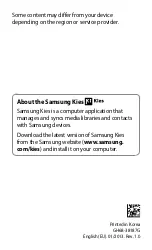
Advanced Router Settings
71
Verizon 4G LTE Broadband Router
Note:
The default DHCP and TCP/IP values work for most users.
3.
Specify the following settings:
•
Device Name
: Your router’s name.
•
LAN TCP/IP Setup:
- IP Address:
Your router’s LAN IP address.
- IP Subnet Mask
: Your router’s LAN subnet mask. Combined with the IP address,
the IP subnet mask lets a computer, smartphone or tablet know which other
addresses are local to it, and which must be reached through a gateway or router.
- RIP Direction
: RIP (Routing Information Protocol, RFC1058 and RFC1389) lets a
router exchange routing information with other routers.
RIP Direction
controls
how your router sends and receives RIP packets. Your router is preset to
Both
.
•
When set to
Both
or
Out Only
, the router broadcasts its routing table
periodically.
•
When set to
Both
or
In Only
, it incorporates the RIP information received.
- RIP Version
: This setting controls the format and the broadcasting method of the
RIP packets that the router sends. Disabled is the default setting.
•
RIP-1 is universally supported. RIP-1 is adequate for most networks, unless
you have an unusual network setup.
•
RIP-2 carries more information. Both RIP-2B and RIP-2M send the routing
data in RIP-2 format.
-
RIP-2B uses subnet broadcasting.
-
RIP-2M uses multicasting.
•
DHCP Server
. For more information, see
DHCP Settings
on page 72.
- Use Router as a DHCP Server
: When selected, the router functions as a
Dynamic Host Configuration Protocol (DHCP) server. See
DHCP Settings
on
page 72.
- Starting IP Address
: Specify the start of the range for the pool of IP addresses in
the same subnet as the router.
- Ending IP Address
: Specify the end of the range for the pool of IP addresses in
the same subnet as the router.
•
Disable NAT/NAPT
: Disable network address and port translation.
•
Address Reservation
: For more information, see
Reserved IP Addresses
on
page 72.
When you specify a reserved IP address for a computer on the LAN, that computer
receives the same IP address each time it accesses the router’s DHCP server. Assign
reserved IP addresses to servers that require permanent IP settings.
4.
Click
Apply
.
















































